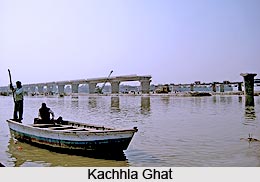 Kachhla is a town and a Nagar Panchayat in Badaun district in the Indian state of Uttar Pradesh. It belongs to Indore Division. It is 404 km away from state capital Bhopal. Jhabua, Godhra and Rajgarh are the nearby cities to Kachhla. Hindi is the local language at Kachhla.
Kachhla is a town and a Nagar Panchayat in Badaun district in the Indian state of Uttar Pradesh. It belongs to Indore Division. It is 404 km away from state capital Bhopal. Jhabua, Godhra and Rajgarh are the nearby cities to Kachhla. Hindi is the local language at Kachhla.
The town is situated on the banks of the holy River Ganga. So there is always a rush at Ganga ghat on the days of Purnima. A large number of people from Rajasthan visit this small town very frequently. The Kachhla town has a 100 year old bridge which is common for both train and bus. It is very popular because of its Ganges banks. Two different bridges are built for traffic and trains.
Demographics of Kachhla
As of 2011 India census, Kachhla had a population of about 20,000. Males constitute 56% of the population and females 44%. Kachhla has an average literacy rate of 30%, lower than the national average of 59.5%: male literacy is 40%, and female literacy is 18%. In Kachhla, 21% of the population is under 6 years of age.
Education at Kachhla
In Kachhla there is an Inter-college situated named Radhey Lal Inter College. It is one of the most prestigious colleges of the state situated on the bank of Ganga which was founded in year 1951. The college provides education to more than thousands of children at Kachhla.
Route to Kachhla
There is no railway station near to Kachhla in less than 10 km. However Vadodara Rail Station is major railway station which is 113 km near to Kachhla.



















